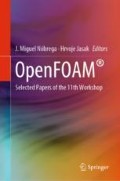Abstract
Turbomachinery simulations represent one of the most challenging fields in Computational Fluid Dynamics (CFD). In recent years, the general CFD capabilities of foam-extend have been extended by introducing and maintaining additional features specifically needed for turbomachinery applications, with the aim of offering a high-quality CFD tool for the study of rotating machinery. This work presents the implementation and validation of new capabilities for turbomachinery with foam-extend, a community-driven fork of OpenFOAM\(^{\textregistered }\). The formulation of an energy equation more convenient for compressible turbomachinery applications has resulted in the rothalpy equation. Rothalpy is a physical quantity conserved over a blade row, stator or rotor, but not over a stage, both stator and rotor. It is fundamental to take into account that the value of rothalpy is not continuous across the rotor–stator interface, due to the change of rotational speed between zones. The rothalpy equation has been derived for both relative and absolute frames of reference, showing that additional terms appear in the absolute frame of reference. Moreover, additional functionality has been added to the rotor–stator interface boundary conditions’ General Grid Interface (GGI), partial Overlap GGI and Mixing Plane Interface, in order to account for the rothalpy jump. The development of these new capabilities and their validation are shown, as well as industrial applications of compressible turbomachinery flows.
Access this chapter
Tax calculation will be finalised at checkout
Purchases are for personal use only
Abbreviations
- e :
-
Energy
- \(h_0\) :
-
Total enthalpy
- i :
-
Rothalpy
- \(\rho \) :
-
Density
- p :
-
Static pressure
- R :
-
Radius
- \(S_H\) :
-
Source term of enthalpy
- T :
-
Temperature
- t :
-
Time
- \(\bar{\bar{\tau }}\) :
-
Viscous stress tensor
- \(\mathbf {U}\) :
-
Rotational velocity vector
- \(\mathbf {V}\) :
-
Absolute velocity vector
- \(V_\theta \) :
-
Component of absolute velocity in the tangential direction
- \(\mathbf {W}\) :
-
Relative velocity vector
- \(\omega \) :
-
Rotor angular velocity
References
Jasak, H. and Beaudoin, M., “OpenFOAM\(^{\textregistered }\) turbo tools: From general purpose CFD to turbomachinery simulations,” ASME-JSME-KSME 2011 Joint Fluids Engineering Conference, American Society of Mechanical Engineers, 2011, pp. 1801–1812.
Cvijetic, G., Jasak, H., and Vukcevic, V., “Finite Volume Implementation of the Harmonic Balance Method for Periodic Non–Linear Flows,” 54th AIAA Aerospace Sciences Meeting, 2016, p. 0070.
Beaudoin, M. and Jasak, H., “Development of a generalized grid interface for turbomachinery simulations with OpenFOAM\(^{\textregistered }\),” Open source CFD International conference, Vol. 2, 2008.
Beaudoin, M., Nilsson, H., Page, M., Magnan, R., and Jasak, H., “Evaluation of an improved mixing plane interface for OpenFOAM\(^{\textregistered }\),” IOP Conference Series: Earth and Environmental Science, Vol. 22, IOP Publishing, 2014, p. 022004.
Lyman, F. A., “On the conservation of rothalpy in turbomachines,” ASME 1992 International Gas Turbine and Aeroengine Congress and Exposition, American Society of Mechanical Engineers, 1992, pp. V001T01A078–V001T01A078.
Ingram, G., Basic concepts in turbomachinery, Bookboon, 2009.
Poinsot, T. and Veynante, D., Theoretical and numerical combustion, RT Edwards, Inc., 2005.
Acknowledgements
Marie Curie Initial Training Network (ITN) AeroTraNet2 of the European Community’s Seventh Framework Programme (FP7).
Author information
Authors and Affiliations
Corresponding author
Editor information
Editors and Affiliations
Appendix
Appendix
The MRF may be formulated using the relative or the absolute velocity formulation. In the first case, the conservation of rothalpy in a moving reference frame is derived directly from the conservation of energy formulated in terms of relative internal energy. It is
When the absolute formulation is used for the MRF, the conservation of rothalpy equations for a steadily moving frame is
This equation has been derived starting from the well-known conservation of energy equation in MRF for absolute velocity formulation [7]:
And substituting the energy expression
leads to
Reorganizing the final terms, Eq. 6 is obtained.
Rights and permissions
Copyright information
© 2019 Springer Nature Switzerland AG
About this chapter
Cite this chapter
De Dominicis, I., Cvijetić, G., Willetts, M., Jasak, H. (2019). Enhanced Turbomachinery Capabilities for Foam-Extend: Development and Validation. In: Nóbrega, J., Jasak, H. (eds) OpenFOAM® . Springer, Cham. https://doi.org/10.1007/978-3-319-60846-4_11
Download citation
DOI: https://doi.org/10.1007/978-3-319-60846-4_11
Published:
Publisher Name: Springer, Cham
Print ISBN: 978-3-319-60845-7
Online ISBN: 978-3-319-60846-4
eBook Packages: EngineeringEngineering (R0)

